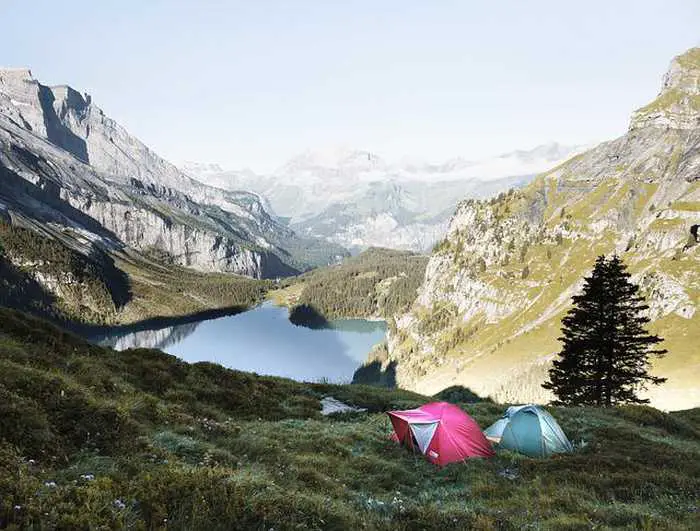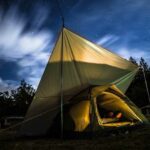There are a few things that make a tent 3 season. First, they are generally designed to be lighter weight than other types of tents. This makes them easier to carry and set up, which is ideal for camping in the spring, summer, or fall.
Second, they are built to protect from rain and wind. The material is usually waterproof and the seams are sealed to keep moisture out. Third, three season tents have more ventilation than other types of tents. This helps keep you cool in warm weather and prevents condensation from building up inside the tent.
How do you check if your tent is waterproof?
One way to check if your tent is waterproof is to look at the seams. From the inside of the tent, you should be able to see that the stitching has a waterproof coating. Another important thing to check is where toggles and ties have been stitched into the seams of the main tent fabric. These also need to be sealed properly in order to prevent leaks during a downpour.
Will a 3 season tent work in winter?
If you’re planning on winter camping or backpacking, you may be wondering if a three-season tent will suffice. The answer is that most three-season tents can indeed be used for winter camping, provided you take a few key precautions.
First, it’s important to set up your tent below treeline, as this will provide some protection from the wind. Second, make sure your tent has strong aluminum or carbon fiber poles; these will stand up better to the weight of snow and ice than flimsier materials.
Finally, bring along sufficient sleeping insulation and warm clothing to ensure you’ll be comfortable in cold weather conditions. By following these simple tips, you can enjoy a winter camping trip even with a three-season tent.
Are 3 season tents waterproof?
Three-season tents are designed to be waterproof. This means that the materials, base, seams, zippers, and rainfly work together to keep water out. Most 3-season tents can handle moderate and higher wind speeds without issue.
What temperature should a 3 season sleeping bag be?
The ideal temperature for a three-season sleeping bag is 20 to 32 degrees Fahrenheit. This range of temperatures will keep you comfortable in most weather conditions. If you are expecting very cold weather, you may want to choose a sleeping bag with a lower temperature rating.
How warm should a sleeping bag be for winter camping?
When it comes to sleeping bags, the warmer the better, right? Well, not necessarily. In fact, for winter camping, a 0º degree sleeping bag will usually be the most comfortable choice.
If you’re fully committed to winter backpacking and only want to carry the minimum weight each trip requires, then you’ll want three sleeping bags: a 15º bag for milder conditions, a 0º bag for colder temperatures, and an expedition level bag (-20º F or lower) for extreme cold weather. But if you’re just getting started with winter camping, one 0º degree sleeping bag should suffice.
Is a 4 season tent worth it?
A 4 season tent can definitely be worth it, depending on what you need it for. If you need extra strength and flexibility in your tent, or if you need extra warmth in colder weather, a 4 season tent can add peace of mind and comfort. However, if you don’t need those things, a 3 season tent may be just as good (and lighter, cheaper, and easier to use).
Can I use a 3 season sleeping bag in winter?
You can use a three-season sleeping bag for winter camping or backpacking if you set it up below treeline, have strong aluminum or carbon fiber tent poles, and bring sufficient sleeping insulation and warm clothing to remain comfortable in cold weather.
What kind of tent do I need for snow?
There are a few things to consider when choosing a tent for snow camping. First, you need to decide what type of snow camping you’ll be doing. Are you planning on winter expedition camping, lightweight mountaineering, or something else? Each requires different types of tents.
If you’re planning on winter expedition camping, you’ll need a four-season tent that can handle high winds and heavy snowfall. The Hilleberg Jannu 2 and NEMO Kunai 2P Tent are both great options. They’re both made for extreme conditions and will keep you warm and dry in the harshest weather. Of course, they come at a premium price tag.
For lightweight mountaineering, the Black Diamond Eldorado and MSR Advance Pro are both excellent choices. They’re designed to be light and easy to carry while still being able to withstand inclement weather. And, they won’t break the bank like some of the other options on this list.

Can I use a 3 season tent in winter?
Yes, you can use a three-season tent for winter camping or backpacking if you set it up below treeline and it has strong aluminum or carbon fiber poles. You’ll also need to bring along sufficient sleeping insulation and warm clothing to remain comfortable in cold weather.
What’s the difference between 3 season and 4 season tents?
There are a few key differences between 3 season and 4 season tents. First, 3 season tents are typically lighter weight and more compact, making them ideal for backpacking trips. They’re also designed to withstand typical backpacker conditions like rain, wind, light hail, and some cold weather. On the other hand, 4 season tents are built to handle everything else – snow loads, high winds, harsh winters, and even blowing sand. So if you’re planning on doing any serious winter camping or mountaineering, you’ll need a 4 season tent.
What is the difference between 3 season and 4 season tents?
When it comes to tents, there are two main types: 3 season and 4 season. As their names imply, the key difference between them is how they perform in different weather conditions.
3 season tents are designed to withstand the typical conditions associated with backpacking: rain, wind, light hail and some cold weather. They typically have less sturdy construction than 4 season tents, which means that they offer less protection from the elements. However, 3 season tents tend to be lighter weight and easier to set up, making them a good choice for backpackers who want to minimize their pack size and weight.
4 season tents are designed to handle everything else: snow loads, high winds, harsh winters and even blowing sand. They usually have stronger construction than 3 season tents, with more robust materials that can better withstand strong winds and heavy snowfall.
Additionally, 4 season tents often have features like internal frames and guy lines that help stabilize them in high winds. However, all of this extra protection comes at a cost: 4 season tents are generally heavier than 3 season models, making them a better choice for car camping or basecamping rather than backpacking trips.
Can you use a 3 season sleeping bag in winter?
It all depends on how cold you sleep. If you find that you’re comfortable using a 3-season sleeping bag in late fall weather, then there’s no reason why you can’t continue using it into winter. However, if you tend to get cold easily, you may want to consider upgrading to a winter sleeping bag for added warmth.
What kind of tent do you need for winter camping?
When it comes to camping in winter, you’ll need a tent that can withstand the elements. A typical three-season tent may work if you’re making camp below tree line and the weather isn’t too bad. However, for high winds and heavy snowfall, a four-season tent is recommended.
Four-season tents are designed to be stronger and more durable than three-season tents. They typically have thicker walls, a sturdier frame, and a waterproof canopy. They also usually have more ventilation options to prevent condensation build-up inside the tent.
When choosing a winter tent, it’s important to pick one that’s spacious enough for all your gear. You’ll want some extra space to store your boots and other gear so it doesn’t get wet or frozen overnight.







